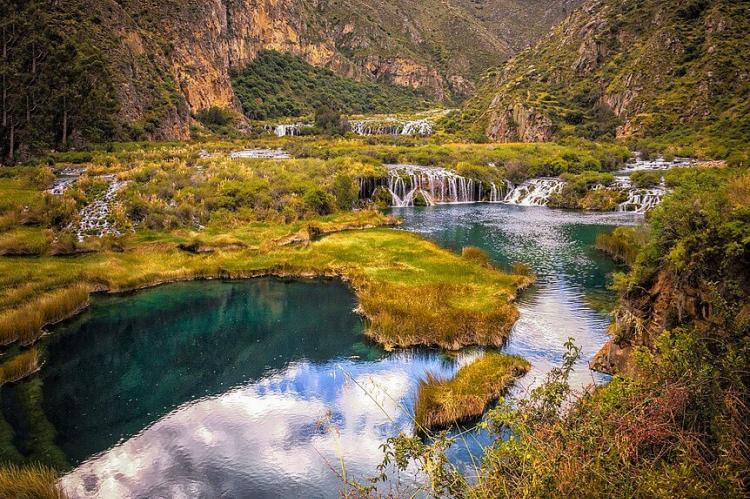Central Andean Wet Puna: Where Mountains and Wetlands Converge
In Peru and Bolivia's southern high Andes, the Central Andean wet puna ecoregion unfolds as a high-elevation, moist, montane grassland. With its snow-capped peaks, mountain pastures, high lakes, plateaus, and valleys, this region above the tree line forms a distinctive composition of landscapes.
Central Andean Wet Puna
Where Mountains and Wetlands Converge
The Central Andean wet puna ecoregion, a gem in Peru and eastern Bolivia's southern high Andean Mountains reveals itself as a high-elevation, moist, montane grassland. Marked by snow-capped peaks, mountain pastures, high lakes, plateaus, and valleys, this region extends beyond the tree line, forming a distinctive composition of landscapes.
Lofty Subregions
-
High Andean Puna: The High Andean Puna, between 4,200 to 5,000 meters (13,780 to 16,400 feet), experiences extreme temperature shifts influenced by the selective force of day-to-night variations. Characterized by oligothermic conditions, where summers dominate the day and winters rule the night, the flora has adapted to these harsh environmental stresses. Nightly freezes throughout the year challenge the resilience of the plants. Annual precipitation, mainly snow and hail, is meager, hovering below 700 mm.
-
Wet Puna: Nestled in the Altiplano at elevations ranging from 3,700 to 4,200 meters (12,100 to 13,780 feet, the Wet Puna encounters a climate of contrasts. Humidity varies from north to south, with the northern areas around Lake Titicaca experiencing eight wet months, while the southern counterparts witness one to two wet months. Average precipitation ranges from 500 to 700 millimeters (20 to 28 inches), and the average annual temperature remains low, fluctuating between 5 to 7 °C (41 to 45 °F). Daily temperature variations are considerable, with frosty nights from March to October.
-
Wet Montane Grassland: The Wet Montane Grassland, located in the eastern section of the ecoregion at an elevation ranging from 3,800 to 4,200 meters (12,460 to 13,780 feet), boasts steep mountains and deep valleys originating from glaciers. This unique topography infuses the grasslands with higher humidity than the puna, creating a lush and humid environment.
Topographical Symphony
The topography of the Central Andean wet puna is a masterpiece, with the Andean mountain range forming a complex network of ridges and plateaus. The Altiplano, a large plateau, adds further intricacy to the landscape, creating a breathtaking visual symphony.
Mountain Marvels and Fragments of Wet Puna
The wet puna is a fragmented beauty in the northern section, gracing the higher elevations of low mountain ranges. The Cordillera Blanca, Cordillera Negra, Cordillera Vilcabamaba, and Cordillera Carabaya contribute to this northern allure. The Cordillera Occidental and Cordillera Oriental, dividing close to the Peru-Bolivia border, showcase additional splendors, including the Cordillera de Apolobamba, Cordillera de Muñecas, Cordillera de La Paz, and Cordillera de Tres Cruces, with the highest peak, Nevado Huascarán, reaching an impressive 6,745 meters (22,129 feet).
Flora and Fauna Extravaganza
The ecoregion is a haven for biodiversity, hosting approximately 1,000-1,500 vascular plant species. Endemic treasures like Culcitium spp., Perezia spp., and Polylepis spp. thrive here, creating a botanical spectacle. Unique wet vegetation communities, including floating submerged cushion plants (bofedales), add to the ecological richness. Notable trees like Buddleja coriacea, Polylepis spp., and the iconic giant rosette plant Puya raimondii paint a vibrant picture.
Wildlife Symphony
The Andean camelids, including the vicuña, llama, guanaco, and alpaca, roam these landscapes, contributing to the rich diversity of fauna. Majestic creatures like the puma and the Andean fox, alongside smaller wonders like bats Histiotus montanus and Lasiurus cinereus, find their home here. The ecoregion hosts unique bird species, including the endangered ash-breasted tit-tyrant, the critically threatened royal cinclodes, the olivaceous thornbill, and the short-tailed finch.
Conservation Imperative
While the Central Andean wet puna is a marvel, it faces challenges from extensive grazing and burning, leading to vegetation degradation and soil erosion. However, dedicated protected areas, such as Manú National Park and the Ulla-Ulla Biosphere Reserve, stand as guardians of this precious ecoregion, emphasizing the crucial balance between human activities and environmental preservation.

Map depicting the location of the Central Andean wet puna ecoregion (in purple).
